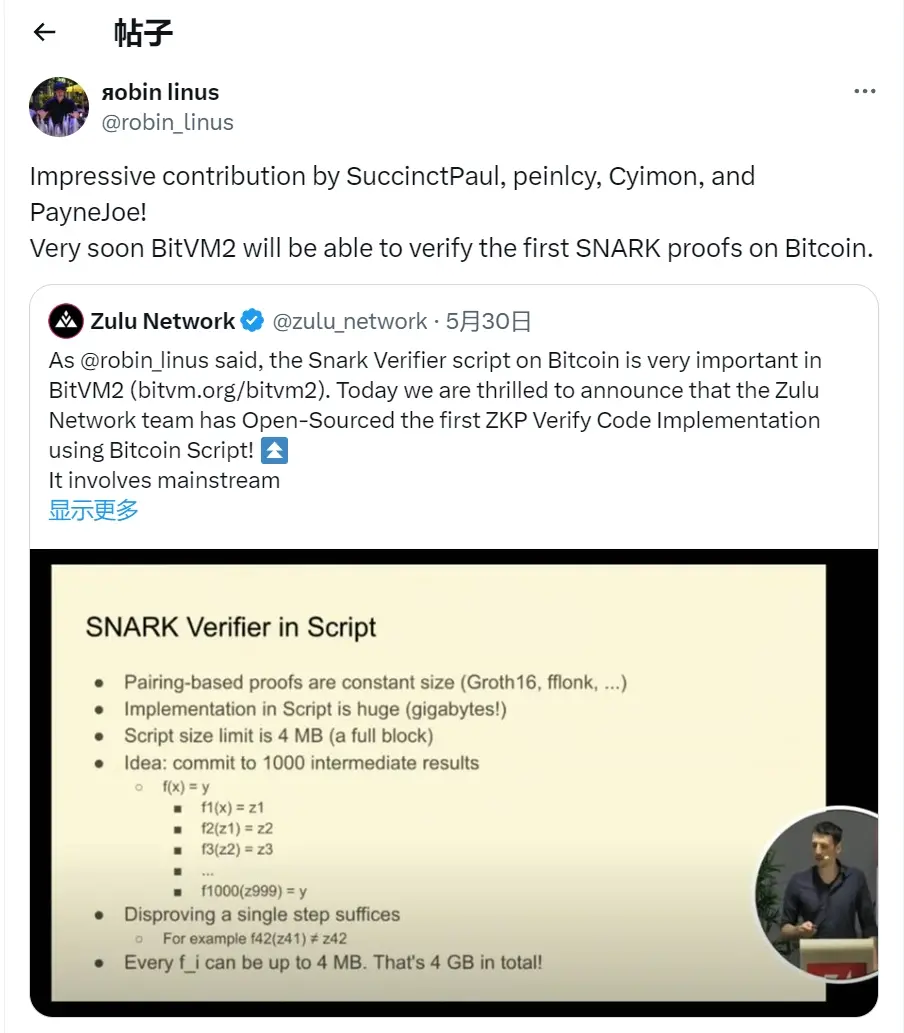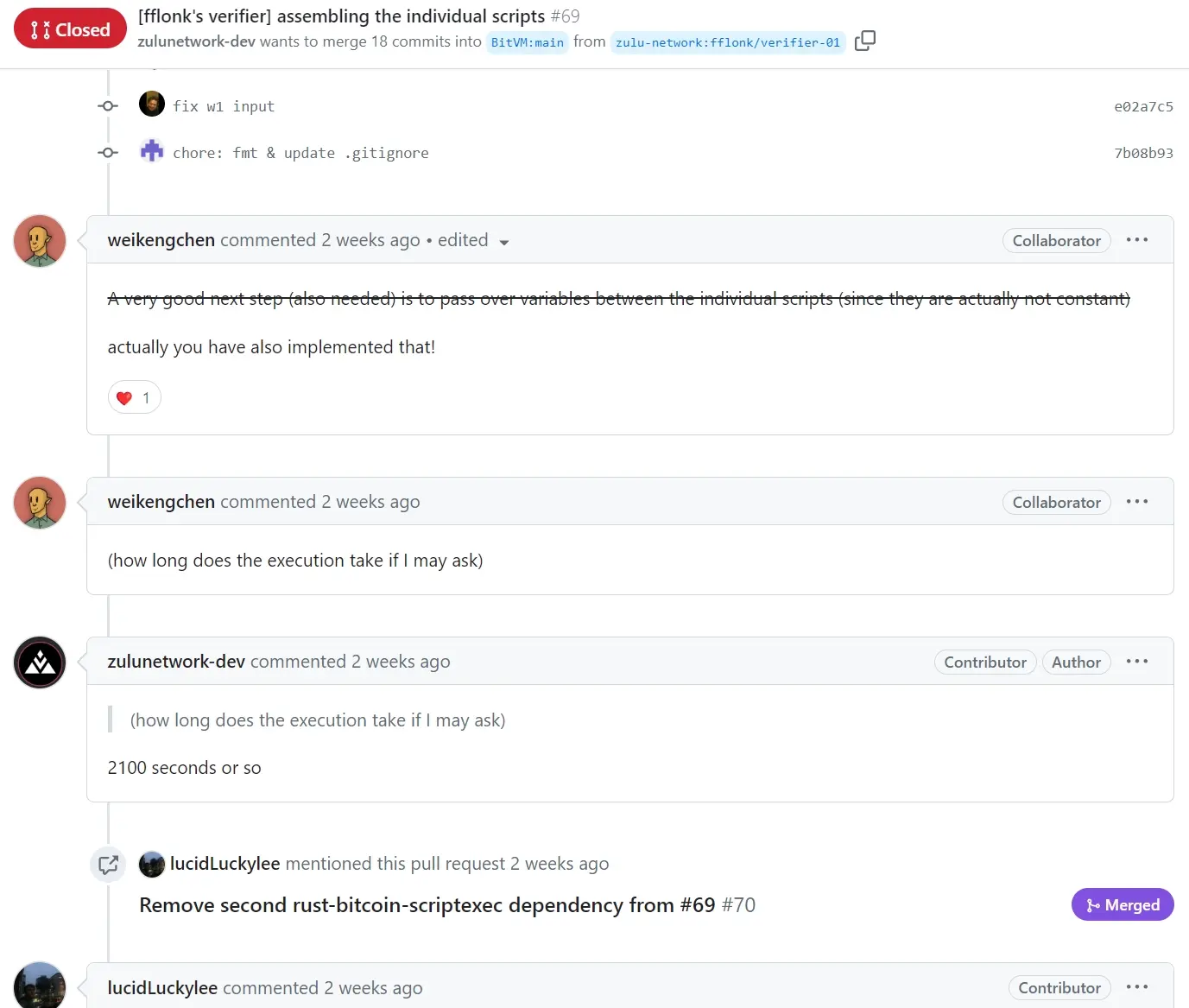The important technological advancement of the Zulu team has been retweeted by Robin Linus, which is expected to accelerate the landing of the Bitcoin L2 era
Since entering June, the price of Bitcoin has steadily risen, once again challenging the $70,000 mark. As of the time of writing, it has already surpassed $71,000. Whether it can maintain this level still requires observation of the U.S. non-farm payroll data, CPI data, and the Federal Reserve meeting trends in mid-June. However, today our focus is not on Bitcoin's market trends, but rather on a star project dedicated to building the Bitcoin ecosystem's infrastructure—Zulu Network.
At the end of May, the Zulu Network team announced the open-sourcing of their ZKP verification code developed based on Bitcoin Script. With this, Zulu Network not only became the first entrepreneurial project in the Bitcoin L2 track to adopt a dual-architecture solution to address a series of issues within the Bitcoin network, but it is also one of the first teams to open-source ZKP verification code, including mainstream algorithms like Groth16 and FFlonk.
Therefore, after the Zulu Network team announced this significant technical advancement on their official Twitter account, they quickly received praise from @robin_linus, highlighting the milestone contribution the Zulu Network team has made to the construction of the Bitcoin ecosystem.

Who is Robin Linus? What is BitVM?
For many web 3 users who do not closely follow the development of Bitcoin's underlying ecosystem, Robin Linus and his BitVM may not yet have the same level of recognition as Ethereum and Vitalik Buterin. However, if you are a player who has been continuously following new developments in Bitcoin, such as inscriptions and runes over the past year, you should be familiar with Robin Linus.
Robin Linus is a developer with considerable influence in the fields of cryptography and blockchain technology. He has made significant contributions to many projects, including the well-known privacy protection projects SecureDrop and Track This, as well as the previously mentioned Zero-Knowledge Proofs (ZKP). Additionally, Robin Linus has been deeply involved in several Bitcoin Improvement Proposals (BIPs), which include optimizations to the Bitcoin protocol, the introduction of new features, and enhancements to transaction efficiency, among others.
As for BitVM, as the name suggests, it is easy to associate it with EVM. So, are these two products of the same nature? It is not a problem to think of it this way for convenience. We know that Bitcoin's native script is difficult to achieve Turing completeness, and BitVM was created to address this limitation of Bitcoin's native script. Using BitVM does not require changing the consensus rules of the Bitcoin network, while significantly improving the transaction efficiency and scalability of the native network, creating conditions for the further prosperity of the Bitcoin ecosystem.
The core developer of BitVM is Robin Linus. In the developer community, Robin Linus is known for promoting technical transparency and the spirit of open source. He believes that technological innovation should serve the public and is committed to advancing technological progress through open and transparent means. This is precisely why, when he retweeted about the technical progress of the Zulu Network team, it garnered widespread attention and discussion. Of course, from another perspective, Robin Linus's attention to the contributions made by the Zulu Network team to the community is not only due to the inherent value of this open-source code but also because the open, inclusive, and innovative spirit of the Zulu team aligns closely with the pursuits of web 3 users, including Robin Linus.
What value does the open-sourced code from the Zulu Network team bring?
If Robin Linus leading and open-sourcing BitVM is the first step in the Bitcoin L2 era, then the open-sourcing of the ZKP verification code implemented by the Zulu Network team on top of Bitcoin Script can undoubtedly be regarded as an important second step, promising to drive the true implementation and flourishing of the Bitcoin L2 era.
Specifically, we can focus on the value contributed by the Zulu Network team's open-sourced code to the Bitcoin ecosystem from the following aspects:
First, it promotes the development of Bitcoin smart contracts. The native script language of Bitcoin is relatively simple and has limited functionality. By implementing ZKP verification, the Zulu Network team has added powerful new features to Bitcoin Script, enabling it to support more complex smart contracts. This technological advancement makes it possible to implement more complex smart contracts on the Bitcoin network, such as financial contracts requiring privacy protection, decentralized identity verification, and more complex decentralized applications (DApps).
Second, it enhances the privacy protection of the Bitcoin network. ZKP verification, commonly known as zero-knowledge proof, is fundamentally a cryptographic technique that allows a prover to demonstrate to a verifier that a certain piece of information is true without disclosing any other information. Introducing ZKP into the Bitcoin network can significantly enhance the privacy protection of transactions.
Third, it improves the security and scalability of transactions. ZKP can be used to verify the legitimacy of transactions without disclosing transaction details, thereby reducing the likelihood of attackers obtaining useful information, which undoubtedly helps enhance the overall security of the Bitcoin network. Additionally, through ZKP, certain complex transaction verification logic can be processed off-chain, submitting only the necessary verification results on-chain. This process greatly reduces the amount of data processed on-chain, helping to improve the transaction efficiency and scalability of the Bitcoin network.
Fourth, it promotes interoperability among blockchain technologies. Implementing ZKP verification on the Bitcoin network can enhance the interoperability between Bitcoin and other blockchain networks. For example, through ZKP, it becomes easier to transfer assets and exchange data between Bitcoin and other ZKP-supporting blockchains. This lays the foundation for further building more complex cross-chain applications, helping to integrate the advantages of different blockchain networks and form a more robust blockchain ecosystem.
Why is the industry placing such importance on developing Bitcoin L2?
A very practical question is that since the start of this bull market, the price of Bitcoin has rapidly surpassed the previous bull market's peak before the block reward halving, and its circulating market value is once again approaching $2 trillion. This means that as the market value of Bitcoin continues to rise, replicating the previous bull market's gains of over 20 times would require a larger influx of incremental funds; otherwise, without changes, miners' earnings would be significantly impacted. Another reason is that although Bitcoin has surged in price over the past year, outpacing Ethereum by a wide margin, the ecological construction of Bitcoin has been rather quiet. The explosion of inscriptions has shown us the hope of improving Bitcoin's scalability, but relying solely on inscriptions is insufficient to sustain market enthusiasm and cannot accommodate the urgently incoming funds. Therefore, naturally, to build a better Bitcoin ecosystem, it is essential to improve the infrastructure and develop L2.
Perhaps we can validate this viewpoint through the development history of Ethereum. The large-scale experimentation of Ethereum's L2 began after the DeFi explosion, driven by user dissatisfaction with the mainnet's inefficiency and high gas fees. However, ultimately, as L2 matured, it fed back into the prosperity of the Ethereum ecosystem.
From the initial Plasma and State Channels solutions to the later Optimistic Rollups and ZK-Rollups solutions, as L2 solutions matured, more and more DeFi and DApps began to operate on L2, reducing users' transaction costs and confirmation times, significantly improving user experience, lowering transaction costs, and increasing transaction speed and network scalability. In November 2021, at its peak, Ethereum's L2 TVL exceeded $100 billion, just a year after the rise of L2.
In contrast, the peak TVL of Bitcoin L2 is only $1.3 billion. The significant difference in this regard is not due to the number of users or funds, but rather the completeness of the infrastructure and the resulting differences in the costs and convenience of deploying and using smart contracts. However, with the continuous innovation of entrepreneurial teams focused on Bitcoin L2 solutions, such as Zulu Network, we have reason to believe that the construction of the Bitcoin ecosystem is on the verge of explosion, and a true Bitcoin L2 era is about to begin.
This is evident from the response to the Zulu Network's open-sourced code in the GitHub community. Within a week of the Zulu team's code being open-sourced, it attracted the attention of many developers on GitHub, who provided numerous suggestions for improving and optimizing the code.

Finally, it is worth celebrating for Zulu that, in addition to the value contributed by the Zulu Network team to improve the Bitcoin network's infrastructure, their open-sourced ZKP verification code has even more far-reaching implications. First, it provides a powerful tool and reference implementation for a wide range of developers, helping community members innovate and improve based on this, thereby promoting the development of blockchain technology as a whole. Second, the open-sourced code also aids in educating and popularizing ZKP technology, helping more developers understand and apply this complex cryptographic technique, promoting its widespread application in blockchain and other fields.







